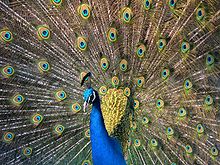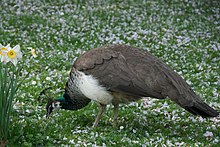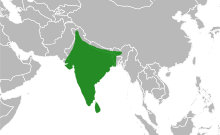Indian Peacock
| Indian peafowl | |
|---|---|
 |
|
| Male (peacock) displaying | |
 |
|
| Female (peahen) | |
| Scientific classification | |
| Kingdom: | Animalia |
| Phylum: | Chordata |
| Class: | Aves |
| Order: | Galliformes |
| Family: | Phasianidae |
| Subfamily: | Phasianinae |
| Genus: | Pavo |
| Species: | P. cristatus |
| Binomial name | |
|
Pavo cristatus Linnaeus, 1758 |
|
 |
|
| Map showing native range | |
The Indian peafowl or blue peafowl (Pavo cristatus), a large and brightly coloured bird, is a species of peafowl native to South Asia, but introduced in many other parts of the world.
The male, or peacock, is predominantly blue with a fan-like crest of spatula-tipped wire-like feathers and is best known for the long train made up of elongated upper-tail covert feathers which bear colourful eyespots. These stiff feathers are raised into a fan and quivered in a display during courtship. Peahens lack the train, and have a greenish lower neck and duller brown plumage. The Indian peafowl lives mainly on the ground in open forest or on land under cultivation where they forage for berries, grains but also prey on snakes, lizards, and small rodents. Their loud calls make them easy to detect, and in forest areas often indicate the presence of a predator such as a tiger. They forage on the ground in small groups and usually try to escape on foot through undergrowth and avoid flying, though they fly into tall trees to roost.
The function of the peacock's elaborate train has been debated for over a century. In the 19th century, Charles Darwin found it a puzzle, hard to explain through ordinary natural selection. His later explanation, sexual selection, is widely but not universally accepted. In the 20th century, Amotz Zahavi argued that the train was a handicap, and that males were honestly signalling their fitness in proportion to the splendour of their trains. Despite extensive study, opinions remain divided on the mechanisms involved.
The bird is celebrated in Indian and Greek mythology and is the national bird of India. The Indian peafowl is listed as of Least Concern by the International Union for Conservation of Nature (IUCN).
...
Wikipedia

